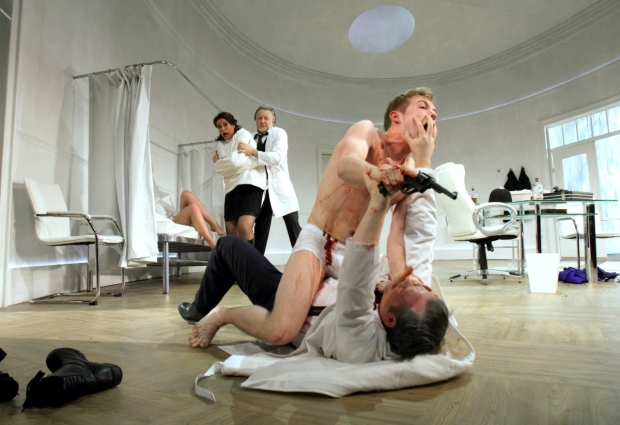Let's Talk About Sets: Michael Taylor on What The Butler Saw

© Catherine Ashmore
Normally when I design a play I turn to a new page of my note book, and go through the play listing the locations, jumps of time, entrances, exits and main actions. And normally this produces a page of notes, maybe two, and gives a rough idea of the shape of the play. What the Butler Saw was unusual: even without any changes of location or jumps in time there were six pages just of entrances, exits and actions. So the first design thought is that the constant entrances and exits need to work smoothly.
Then it's a question of balance. In some ways Orton’s play is fabulously artificial and lives in its own world. The characters are as divorced from the world outside the consulting room as Robinson Crusoe. Although the clinic must have other staff – Matron is referred to – not even gunfire brings them in. I was reminded of Tim Burton’s Beetlejuice where, when the young husband tries to leave the house in which he is trapped, he finds the neighbourhood is now a lurid desert stalked by monsters. Is this the relationship of the consulting room to its surroundings? Do we go surreal to show it? We very seriously considered a set which would get smaller over the length of the play, going from an elegant consulting room to a tiny cell with the characters all in a struggling heap. (The argument against this was partly of timing: when would the room actually shrink?)

So on the one hand the set needs to be something theatrically exciting that reflects these aspects of the world of the play. And on the other hand, comedy needs reality: if there isn’t a real world setting up norms of behaviour then nothing is funny. In a fantasy world anyone can say anything. If everything is odd, nothing is odd. So the need to balance oddity against reality pushed the set in the direction it has taken: the room with curved walls could from an architectural standpoint have been built in avant-garde north London at any time since the '20s, but at the same time it’s a sealed white box, its confinement cranked up with a raked floor and ceiling and a forced perspective.
Another interesting question was period. It’s a modern play. Plot and dialogue details place it in 1969 when it was written but we didn’t want to stress that: hence a look for props and costumes that although not impossible in 1969 would feel more contemporary.
A last issue was the two very different theatres where the production is staged: Leicester Curve and Bath Theatre Royal. The Curve is huge with a very wide front row, Bath is a relatively narrow traditional proscenium theatre. So the set has two versions, one four feet wider than the other, each with a different curved piece for the upstage doorway.
And then there are all the practical problems: doors opening on sloping floors, doors sliding on sloping floors, how big is that vase?
By Michael Taylor
What the Butler Saw runs at Curve, Leicester until 18 March and Theatre Royal Bath from 27 March to 1 April.










